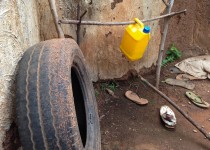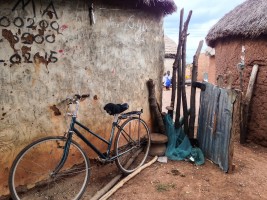In Ghana, one in every thirteen children dies before the age of five, with malaria and diarrhea the leading killers. C4D is working to reduce child mortality rates by improving awareness – and behavior change – around five key health behaviors using various communication strategies, such as mobile voice messages and community radio programming. The evaluation is designed as a randomized control trial and has been complemented by qualitative research.
Thus far, the baseline and qualitative findings indicate that levels of knowledge and awareness of health behaviors by respondents are relatively high, yet gaps in practice remain, underlining the structural barriers and behavioral factors that can preclude people from acting upon any existing knowledge.
Let’s think about these challenges in an everyday setting: I never exercise. I know that my health – and my abs – could be improved if I broke into more than a light sweat every day. My behaviors, however, are plagued by time inconsistency – the idea that the way a person plans to act in the future will be different from what the person actually does – and the lack of a conducive social setting (i.e., having the pressure of ‘everybody’s doing it’).
continued below
Animation - What is an Randomized Controlled Trial? from Strategic Impact Evaluation Fund.
Now put these challenges in the context of a developing country. The baseline survey reported that approximately three quarters of respondents heard about exclusive breastfeeding, but almost 30 percent gave water to their less than six-month-old child the day before the survey, potentially exposing them to water borne illnesses. Focus group participants noted the benefits of exclusive breastfeeding, but provided examples of infants who were given water while under the care of older family members set in unwavering habits and traditions. Similarly, 92 percent of baseline respondents reported that they believed that a healthcare facility was the best place to deliver. However, for their last pregnancy, approximately 47 percent of respondents delivered at home. Qualitative findings pointed this to social barriers faced by women, who often require permission from their husbands and in-laws in order to leave the house. Distance to health facilities was also a barrier, compounding delays and forcing women to deliver at home.

Though the evaluation is not yet complete, these findings have already provided a useful examination of child and maternal health patterns in northern Ghana. So where do we go from here? The results will be circulated within IPA and to UNICEF, implementing organizations, and academic circles, but how can these findings reach a larger audience and potentially have a wider impact?
Mass and effective dissemination of information is a known problem within the research community. Recently the World Bank found that one-third of its electronic reports
have never been downloaded – meaning they had never been seen by the public (or frantic graduate students doing last-minute reading before class). The IPA Ghana office has been working to improve its communication strategies, most recently holding a
dissemination event for local stakeholders and releasing monthly newsletters to update them on the progress of relevant programs. Funders and research organizations should place higher importance on such communication-related activities as well as engagement with relevant development actors on research results. This includes not only reaching policymakers and development organizations, but community-based stakeholders and research participants as well.
For me, this summer has brought to light the importance of getting research-related information to the right people – for all development actors, bottom to top, to have greater access to information on the successes and failures of past and ongoing projects. Further, the potential benefits of research respondents being equipped within this information should not be overlooked. Candid discourse on project findings could provide a space for community members to discuss issues that are not normally spoken about, which can act as a step forward for addressing any existing social barriers.
This is what local ownership is about: communities taking charge of their own development, equipped with the information to do so in an informed way.



